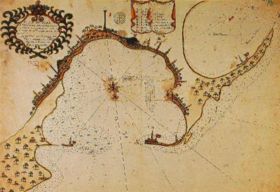Alexandria
 From Conservapedia
From Conservapedia Alexandria, the capital of Ancient Egypt during the Ptolemaic era, was the center of the Hellenistic intellectual world. The origins of the city are still unknown, though it is now believed to date back to at least the New Kingdom. The city was greatly expanded by the Greek architect Dinocrates (332-331 BC) at the orders of Alexander the Great. Egypt was ruled from Alexandria by Ptolemy's descendants, until the death of Cleopatra VII in 30 BC.
Nearly 300 years before Cleopatra, her ancestor Ptolemy I Soter had witnessed the expansion of the city, now named Alexandria, and wanted it to be the cultural and intellectual capital of the world. Under the reign of Soter, the golden age of Alexandria, the new capital of Egypt, started. It was the site of the Pharos Lighthouse, one of the Seven Wonders of the Ancient World, as well as the Great Library.
The Pharos lighthouse was built on the island of Pharos off the coast. The Library at Alexandria, founded under the reign of Ptolemy II, was conceived largely as an attempt to bring together in Alexandria the whole of the earlier Greek science, art, and literature. At one point, the Library is believed to have held close to fifty thousand books (as scrolls). The eventual fate of the Library is uncertain, but fires burned much of the contents, except a separate library-index room, which contained an index of the names of scrolls which had been stored in the Great Library.
Today Alexandria is the second largest city and the main port of Egypt.[1] The city is one of the main transportation hubs in Egypt after Cairo, having two international airports, a major deepwater harbour (which, until recently, had international ferry services to Italy, Greece and Cyprus) and is a major terminus for intercity rail services. It is also served by the only high-speed rail line in Egypt, linking Alexandria with Ramesses station in Cairo. The Desert Highway expressway (a tollroad) also terminates in Alexandria, connecting the city with Cairo and bypassing the densely populated Nile Delta.
The city has a catacomb system, underground, which is part of the water system. The tomb of Alexander the Great is believed to be hidden inside the walls of the catacomb, and its location is a major archaeological mystery.
See also[edit]
External links[edit]
References[edit]
Categories: [Ancient Greece] [Egypt]
↧ Download as ZWI file | Last modified: 02/28/2023 00:03:41 | 44 views
☰ Source: https://www.conservapedia.com/Alexandria | License: CC BY-SA 3.0
 ZWI signed:
ZWI signed:
 KSF
KSF